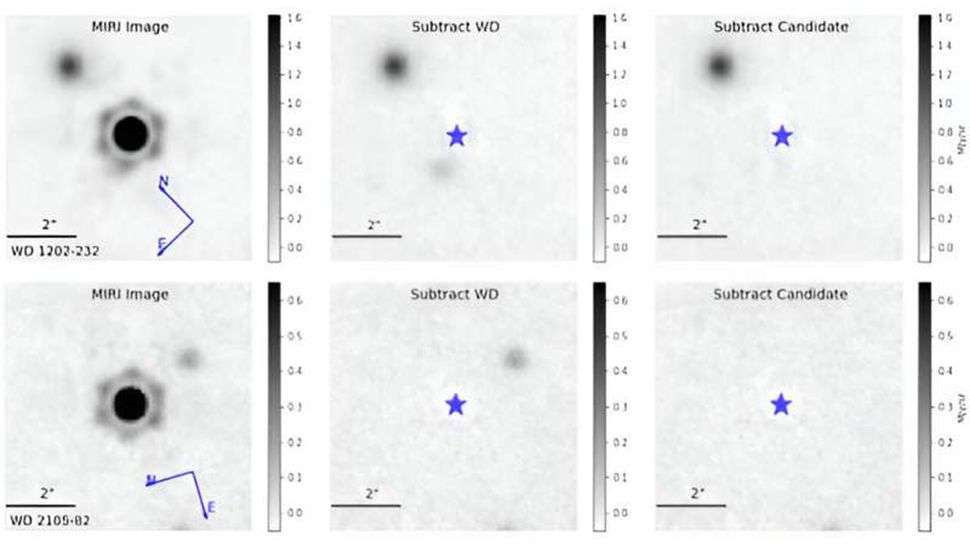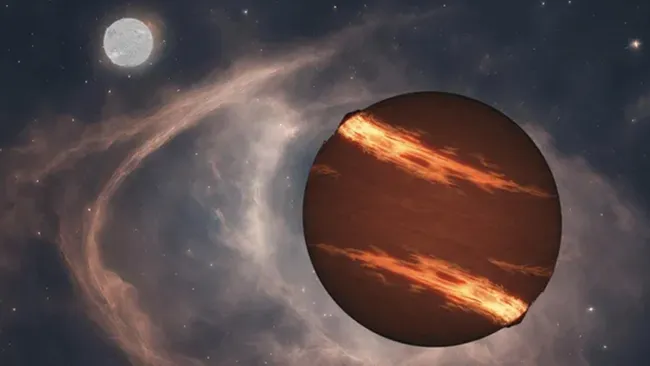The James Webb Telescope Achieves Rare Discovery: Two Planets Orbiting Deceased Stars
The James Webb Space Telescope has detected two alien planets orbiting white dwarfs, the collapsed husks of once-mighty stars. The discovery offers a hint of what our solar system will look like after the sun’s eventual demise.
The James Webb Space Telescope (JWST) has already demonstrated its ability to observe distant objects and provide insights into the past. However, a recent breakthrough has allowed the powerful instrument to offer a glimpse into the future of our solar system, almost like a scientific crystal ball.
During its observations, the JWST detected two exoplanets orbiting two different white dwarfs, which are dead stars. These exoplanets bear a striking resemblance to the gas giants Jupiter and Saturn in our own solar system. Additionally, the white dwarfs themselves serve as analogs to the eventual fate of our sun. When the sun transforms into a white dwarf, it is likely to destroy the inner planets of our solar system, including Jupiter.
The discovery of planets around white dwarf stars is quite rare, making these two candidate planets even more extraordinary. They share similarities with the planets in our outer solar system in terms of temperature, age, mass, and orbital separation. Susan Mullaly, the lead author of the research, explained that this provides a unique opportunity to observe what a planetary system looks like after its star has died.
A snapshot of our future
The JWST’s Mid-Infrared Instrument (MIRI) directly observed the planet candidates as they revolve around the white dwarfs WD 1202-232 and WD 2105-82. One exoplanet candidate is situated at a distance from its white dwarf host that is approximately 11.5 times the distance between the Earth and the sun. On the other hand, the second candidate is positioned farther from its deceased stellar parent, at a distance of roughly 34.5 times the separation between our planet and star.
The masses of these planets are currently uncertain, with Mullaly and colleagues estimating them to range between 1 and 7 times the mass of Jupiter, which is the most massive planet in our solar system.
In approximately 5 billion years, when the sun depletes its fuel supply for the nuclear fusion processes occurring at its core, it will expand into a red giant. However, nuclear fusion will persist in its outer layers. As a result, these outer layers will extend as far as Mars, engulfing Mercury, Venus, Earth, and potentially even Mars itself. Eventually, these outer layers will cool down, leaving behind a glowing stellar core, now transformed into a white dwarf, surrounded by a planetary nebula composed of exhausted stellar material.

These detections of exoplanets, however, provide a glimpse into the potential fate of planets beyond Mars, specifically the gas giants Jupiter and Saturn, when our sun eventually dies.
According to Mullaly, our sun is projected to transform into a white dwarf star in approximately 5 billion years. After the death of a star, it is expected that planets will gradually move outward, into wider orbits. By rewinding the clock on these potential planets, it is reasonable to assume that their orbital separations would have been similar to those of Jupiter and Saturn.
If these planets can be confirmed, they would serve as direct evidence that gas giants like Jupiter and Saturn have the ability to survive the demise of their host star.
Furthermore, the white dwarfs at the center of this discovery exhibit contamination from elements heavier than hydrogen and helium, commonly referred to as “metals” by astronomers. This finding may shed light on what could occur to the bodies within the asteroid belt situated between Mars and Jupiter once the sun perishes.
Mullaly explains that it is suspected that the giant planets are responsible for the metal pollution by causing comets and asteroids to collide with the surface of the stars. The presence of these planets strengthens the link between metal pollution and planets. Given that 25% to 50% of white dwarfs display this type of contamination, it suggests that giant planets are prevalent around white dwarf stars.
Consequently, any surviving asteroids following the sun’s demise could potentially be bombarded by Jupiter and Saturn as they orbit the lifeless star.
This dual discovery not only offers insights into the future of our own planetary system but also represents a remarkable scientific accomplishment.
A rare direct exoplanet detection
Since the initial detection of exoplanets in the mid-1990s, astronomers have identified approximately 5,000 planets that orbit stars outside of our solar system. However, according to the Planetary Society’s data as of April 2020, only 50 of these exoplanets have been directly observed through imaging techniques.This limited number of direct observations can be attributed to the challenge of detecting the faint light emitted by exoplanets amidst the overwhelming brightness of their parent stars. It is akin to trying to spot a firefly perched on a lit lamp of a lighthouse.
Consequently, astronomers primarily rely on indirect methods to detect exoplanets. These methods involve observing the effects exoplanets have on the light emitted by their host stars. This can include a decrease in light output when the exoplanet passes in front of, or “transits,” the star, or detecting the gravitational “wobble” caused by the planet’s influence on the star.However, in the case of the two exoplanets directly imaged by the JWST, their pictures reveal the light emitted by the planets themselves. This breakthrough allows scientists to delve deeper into the study of these worlds. They can now investigate factors such as the composition of the planets’ atmospheres and directly measure their masses and temperatures.
Mullaly, a member of the research team, emphasized that the discoveries made about these exoplanets were not entirely anticipated. These unexpected characteristics could potentially reshape astronomers’ understanding of exoplanets in general.Alternatively, the peculiarities observed in these targeted worlds may provide intriguing clues regarding the existence of sought-after exomoons.
Mullaly concluded that it is surprising that these planets are not as red in the mid-infrared as anticipated, considering their status as exoplanet candidates and their age. The brightness of the light collected by JWST at 5 and 7 microns exceeds expectations. This finding could potentially challenge our current understanding of exoplanet atmospheres in terms of physics and chemistry. Alternatively, it could suggest the presence of another light source, such as a heated moon orbiting the planet. The team’s research can be accessed as a preprint on the research repository site arXiv.
This article is republished from livescience under a Creative Commons license. Read the original article.
Do not forget to share your opinion with us to provide you with the best posts !




0 Comments